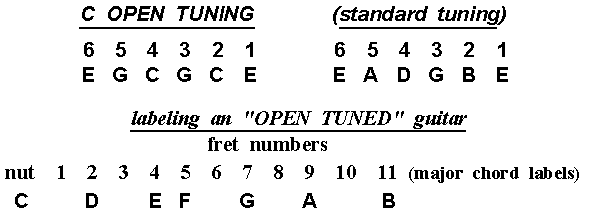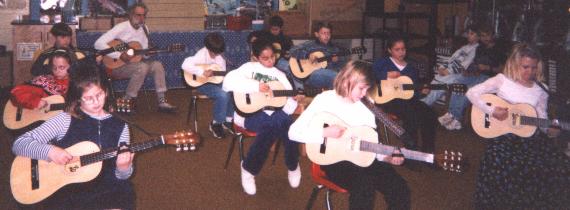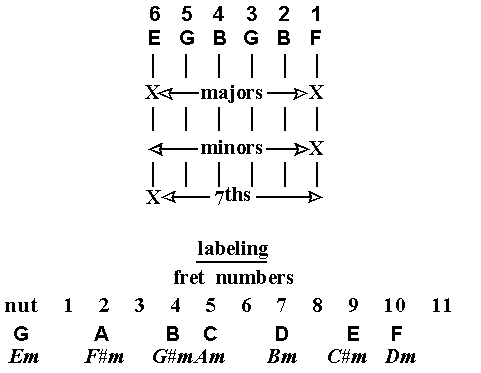Simplified for Everyone
Article 2
Teaching All Elementary School Aged Children
to Play the Guitar
A New Method
Introduction
You can now easily teach all your elementary school aged children to play the guitar, even though you may have never played the instrument yourself. A new simplified method, developed through the auspices of the South Carolina Arts Commission and tested in several South Carolina elementary schools, has enabled music teachers with no prior guitar playing experience to teach groups of Kindergarteners through 6th graders to easily play the guitar. (The method applies to all middle and high school students as well.)
Although this may seem hard to believe, it is true. And the children, of course, love it, as do their parents, who have been amazed by performances of large elementary school guitar "orchestras". There are no fingerings involved at all. Instead, utilizing "open" tunings similar to ones pioneered by Carl Orff, the guitars are, first, "open strummed" by the younger children to accompany multi-chord songs, and next, at an older age (usually starting with 4th graders), are chorded with a new "barre chorder", somewhat like a slide.
A special new guitar pedagogy has been developed for full sized regular music classes (the children work in teams of two, so you only need guitars for half the class), requiring just a month or two of playing, once a week, at each grade level each year. By the time the students leave for middle school, they are prepared to play multi-chord songs on any guitar for the rest of their lives. It is really a fun and easy method to teach. Here is an outline of how it is done.
Pre-K Through 3rd Grade - The "Open Strumming" Technique
Using Small Open 5th Tuned Guitars, Strummed "Open" (No Fingerings or "Barreing"), to Accompany Any Song
The ideal way to start very young children out on the guitar is to put small 1/2 and 3/4 sized instruments in their hands and specially tune them to an "OPEN 5th" 2-note chord like you would a dulcimer. The "C OPEN 5th" TUNINGS are shown below (you can also use soprano and baritone ukuleles, as well as dulcimers):

The real beauty of using "open 5th" tuned instruments is that children just strum across all the strings "open" (meaning the left chording hand is not involved at all) to accompany any song in the KEY of C, and no matter what chords are involved in the song, this "drone" part will naturally harmonize with the music. The children get the "feel" of the instrument and are able to just focus on strumming in time with the music, while contributing an integral harmony part to any and all singing activities as well.
Using Capos to Play in Other Keys
If the song to be accompanied is in some KEY other than C, all you have to do is place a capo on each child's guitar at the LABELED FRET corresponding to the KEY the song is in. The easiest way to do this is to put little adhesive backed dots on the side of the neck at the appropriate frets and mark them as shown below. In so doing, you'll immediately know where to place the capo for any particular KEY:

Note: capos don't work very well on soprano ukuleles and are available for dulcimers.
As you can see, the progression of labels along the fretboard is the same as the progression of notes along a KEYBOARD. The frets with no labels are the sharps and flats. So, for example, if you are going to be singing a song in the KEY of Eb, and you want to have several children accompany the rest of the class on guitars while everyone else sings, just place a capo on each guitar at the 3rd fret and let the children strum across the strings "open". You can use just 2 to 6 small guitars with these younger children and organize your lesson plans so that you are singing in just one or two keys per day. The children can take turns playing and can accompany any song in this way. Young children absolutely love to do this.
Inexpensive 1/2 (30") or 3/4 (34") nylon string (classical) guitars are best. The nylon strings are easier on the children's fingers and mellower sounding. The children do need to be reminded not to touch the tuning machines (show them how they work), and if they are using picks (use large "thin" flat picks), not to put them in their mouths or try to get them out of the guitar if they fall into the sound hole. Younger children are absolutely enchanted, and tend to become very calm and relaxed, when given the opportunity to play the guitar. Strumming is a wonderful rhythm development exercise. Remember, you don't need to have lots of instruments to facilitate this activity. Children can take turns every day and keep in mind that you can accompany any and all singing activities in this way.
4th Grade And Up - The "Barre Chording" Technique
Utilizing "Open Tuned" Guitars and an Easy to Use "Barre Chorder"
With No Fingerings, to Play All Major Chords
When children reach this age and grade level they are ready to begin working on playing "barre" chords with some sort of "barre chording" device like the GUITAR BARRE® for example. This simple to use tool, a hybrid of two frequently used guitar playing "tools", the "slide" and the "capo", enables children to easily play "barre" chords. A "barre" chord is produced when all the strings are pushed down together at a particular fret. This is very difficult to do just with the finger, and even with a traditional "tool" like a "slide". But with a tool like the GUITAR BARRE®, with finger rest, neck "gripper" and "soft" bar, children can immediately play "barre" chords. There are no complicated, uncomfortable and frustrating fingerings associated with this new method. Children can successfully play two chord songs after just their second lesson.
This new pedagogy is very similar in many respects to techniques taught in intermediate to advanced guitar classes, and therefore should in no way be considered cheating, nor seen as a radical departure from traditional methods. The problem for beginners with these traditional barre chording techniques has always been their high degree of difficulty, and in the case of using a "slide", the quality and type of sound produced.
Barre chording methods often depend upon using what is called an "OPEN TUNING", meaning that the strings are tuned to a major chord. The real advantage of using "OPEN TUNINGS" is that a different chord can be played at each fret (labels can be placed along the fretboard to indicate the chords so that there is nothing to memorize). If the guitar is "OPEN TUNED" to a C CHORD, then the fretboard can be labeled as indicated below (the difference between the "STANDARD" and an "OPEN TUNING" is also shown). Note, once again, how convenient it is that the progression of major chords along an "OPEN TUNED" fretboard (see the labeling scheme) mirrors the progression of notes along a piano keyboard.

(the sharps and flats are at the frets between the naturals, just as on a keyboard)
The Simplicity of Teaching Children Multi-Chord Songs
Suppose you would like to teach all of your 4th grade music classes to play multi-chord songs on the guitar. All you'll need is one guitar for each pair of students, so they can take turns, observe, and help each other out. After starting out playing some simple one chord songs like ROW, ROW, ROW YOUR BOAT; ITS RAINING, ITS POURING; A TISKET, A TASKET; RING AROUND THE ROSIE; PEASE PORIDGE HOT; RAIN, RAIN, GO AWAY; STAR LIGHT, STAR BRIGHT, etc., all where they just "open strum" the C chord, you can immediately move into two chord songs in the second lesson.
To play a two chord song like THE WHEELS ON THE BUS in the Key of F, strap the "barre chorder" onto the hand of each player and have them all start playing a F chord by pushing down all the strings at the F labeled fret as they strum across the strings with their other hand. When it comes time for the C chord in this two chord song, have them tilt the "barre chorder" off the strings slightly and strum the "open" C chord. Instantly the children are playing a multi-chord song. It could not be much easier. They are ecstatic, as you might well imagine. Soon you can move on to three chord songs in a similar fashion, usually in lesson four or five .

Half a class of 5th graders takes its turn at playing a two chord song with a "barre chorder" during just their second lesson
 The CHILD'S BARRE®
The CHILD'S BARRE®(or DULCIMER BARRE®)
Using the Child'S Barre® in Special Situations
The CHILD'S BARRE®, pictured to the right, originally designed for barre chording dulcimers, can also be used for chording guitars when held flat. This is a great beginning chording technique for children ages 5 - 8, and for any age person who has problems using the GUITAR BARRE®. This is particularily applicable to special populations more commonly dealt with by music therapists. It should be added that dulcimers are ideally suited to younger and special populations, and that chording them with the DULCIMER BARRE® is extremely easy.
Dealing with Minor Chords - Substituting the Relative Major
It seems to be a well kept secret among most music theorists, that for most songs (those written in major keys), you can substitute the "relative major" of any minor chord in a song and the substitute major chord will harmonize nicely with the melody. After all, a song is really defined by its melody - how often have you encountered the same song arranged differently as far as the chords are concerned. It happens quite a bit, especially in arrangements designed to simplify a piece of music. By adding a set of "relative minor" labels to the fretboard (please see the illustration below), students will be ready to play any song with minor chords as well. When you encounter a minor chord in a piece of music, simply barre at the fret with that minor chord label, and you'll automatically get the harmonically substitutable "relative major" chord, and the song will come out sounding fine. (If you want to barre real minor and dominant 7th chords, along with majors, see the note in the box below - this applies to older students and adults.)

Note: at the MIDDLE SCHOOL level and above there is an optional new "MODIFIED OPEN G TUNING" where students can barre all major, minor and dominant 7th chords:

It basically works like this. As students become older and a little more experienced, they quickly pick up on how to finger pick chords. This gives them the control they need to play only the middle 4 strings for major chords, strings 6 through 2 for minor chords, and strings 5 through 1 for dominant 7th chords. The labeling scheme begins with (Em) G at the nut. For example, barreing at the 5th (Am) C labeled fret and leading with the 6th string and excluding string no. 1 produces Am, picking among strings 5 - 2 produces C major, and leaving out just string no. 6 produces C7 (an X means don't play that string). Music teachers who would like to play all major, minor, and dominant 7th chords will love this. But don't start out trying this unless you already have a little playing experience behind you. It takes a little time to get finger picking and finger positioning down. (Note: if one is not concerned about playing dominant 7ths, the 1st string can be tuned to D and included in playing major chords.)
Summarizing Some of the Advantages of Teaching All of Our Children to Play the Guitar
Teachers now have at their disposal a simple means of empowering all elementary school aged children to play the guitar. The method is very easy to teach, even when working with full classroom sized groups. This new pedagogy is being taught in a dozen or so elementary schools throughout the state of South Carolina. The children are learning to play the guitar almost instantly, and are using the instrument to not only accompany their regular singing activities and in performances, but as a vital link in learning some very basic music theory concepts. Most of the teachers using this new method had no previous guitar playing experience themselves and are enjoying the benefits of playing the guitar as well.
The primary advantage of this new beginning guitar pedagogy over the 'standard tuning fingering' approach is simply that everyone succeeds immediately. With the help of fretboard labels and a "barre chording" device, playing chords on the guitar becomes extremely easy. And if students want to go on and learn the 'standard tuning fingerings', it is much more likely they'll succeed, having started out with this new approach. Children are learning to play an instrument they really want to play using a method that will enable them to pick up and play the guitar at any time they wish in their adult lives. Maybe they'll want to play their own children a bedtime lullaby, and thereby foster an early love for and appreciation of instrumental music at home. Maybe they'll take the guitar to church and teach a youth group to play AMAZING GRACE. The possibilities of empowering everyone to play the guitar are limitless.
Examples of Music Concepts Better Understood Through Hands-On Guitar Playing by Elementary and Middle School Aged Children
For teachers wanting to introduce students to keyboards, what better way than to reinforce the concept of a 12 tone chromatic scale through the use of an identical labeled "open" tuned guitar fretboard. And now that the guitar is so easy to chord, what better way to introduce students to the world of chords and the concept of harmony.
At the upper elementary and middle school levels, teachers can use the guitar to teach the meaning of changing KEY and transposing music. For example, a I - IV - V chord progression sung in the KEY of C is pitched in a certain way and goes from a C to a F to a G chord. On an "OPEN TUNED" fretted instrument like the guitar, starting with the I chord, the IV chord is always 5 frets down the fretboard, and the V chord is another two frets down. If you want to raise the pitch of a song to the KEY of D for example, begin by barreing the D chord, and then to find the IV chord count down 5 frets (G), and then count down another two frets for the V chord (A). Presto, we have a simple formula (which is easily reduced to a visual pattern) that upper elementary aged students can use to change (transpose) a song to better fit their unique vocal range. And that, by the way, is one of the other advantages of using an "OPEN TUNED" guitar - it is easy to play any song in any KEY.

Conclusion
Music teachers will be pleased to know that lesson plans and a video have been produced to help them get started teaching the guitar in their classroom. You can start out with your lower grades just using a couple of small guitars in the "OPEN STRUMMING" mode, and then gradually move on to teaching your regular 4th grade and above music classes to play "barre chords". You can expect the total cost of 15 guitars and "barre chorders" (enough for half of the students in your largest class) to be under $1500. And remember, even if you have never played the guitar before yourself, you and your students will easily succeed using this new method.
Some thoughts for college level music methods teachers
This new barre chording technique is a perfect beginning method for all elementary music education and music therapy majors and even all early childhood elementary education majors as well. Very few of these aspiring teachers would ever use the guitar in their classrooms if they had to rely on the traditional fingering method - they could all be playing using this new alternative approach (fact - most music teachers and music therapists taught traditional fingering methods in school do not continue on to play because of the inherint difficulties associated with that approach). Any general music methods teacher could be teaching this method. No prior guitar playing experience is necessary.
Where to Go for More Information
To get started, all you'll need are the following: something like the "GUITAR BARRE®" chording device: THE BEGINNING GUITAR SIMPLIFIED GUIDE FOR EVERYONE in C and VIDEO, THE COMPLETE GUITAR, BANJO and UKULELE METHOD BOOK in G and VIDEO, and THE COMPLETE GUIDE TO TEACHING GROUPS TO PLAY THE GUITAR with companion VIDEO.
Note: As of January 1999, this article had not been published. If you could help facilitate that happening, and or you would like permission to re-print, please contact us. Thanks.
WOULD YOU LIKE TO TEACH GROUP GUITAR LESSONS?
(no prior guitar playing experience necessary)
WOULD YOU LIKE TO SELL GUITARS AND ACCESSORIES TO YOUR STUDENTS?
(you can purchase through us at wholesale prices)
If your answer to either of the questions above is yes, feel free to email us at:
dickbozung@guitarsimplified.com .
• • •